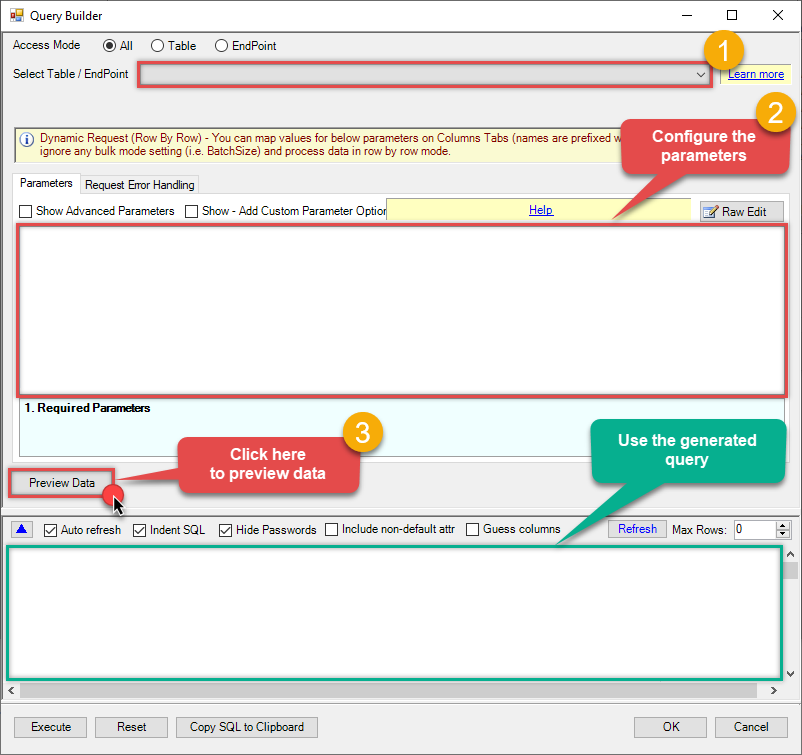Azure DevOps Connector for SSAS How to Query Work Items
Introduction
In this article we will delve deeper into Azure DevOps and SSAS integration, and will learn how to query work items. We are continuing from where we left off. By this time, you must have installed ODBC PowerPack, created ODBC Data Source, and configured authentication settings in your Azure DevOps account .
So, let's not waste time and begin.
Use Query Builder to generate SQL query
-
The first thing you have to do is open Query Builder:
ZappySys API Driver - Azure DevOpsAzure DevOps Connector can be used to integrate Azure DevOps (Cloud or On-Premises) data in your App / BI Tools. You can create, read, query, modify, and delete WorkItems, Projects, Teams and more.AzureDevopsDSN
-
Then simply select the Query Work Items endpoint (action).
-
Continue by configuring the Required parameters. You can also set optional parameters too.
-
Move on by hitting Preview Data button to preview the results.
-
If you see the results you need, simply copy the generated query:
-
That's it! You can use this query in SSAS.
Let's not stop here and explore SQL query examples, including how to use them in Stored Procedures and Views (virtual tables) in the next steps.
SQL query examples
Use these SQL queries in your SSAS data source:
How to Get work items for the default project(specified by connection settings)
SELECT * FROM WorkItemsHow to Get work items for the specific project
SELECT * FROM WorkItems WITH (Project='ProductTesting')How to Get work items with ParentId
By default some fields like ParentId is not returned to speed up, if you wish to populate that field then set Expand='Relations'
SELECT * FROM WorkItems WITH(Expand='Relations')How to Create a query to get work items by the Id of the work items in the default project for the organization
To learn more about Query syntax refer to this link https://learn.microsoft.com/en-us/azure/devops/boards/queries/wiql-syntax?view=azure-devops and this link https://learn.microsoft.com/en-us/azure/devops/boards/queries/query-operators-variables?view=azure-devops
SELECT * FROM WorkItems WITH (Query='SELECT * FROM WorkItems
WHERE [System.Id] > 2000 AND [System.Id] < 7050
AND [System.TeamProject]=''ProductTesting''
AND [System.ChangedDate] < @Today
AND [System.CreatedDate] > @StartOfYear
AND [System.WorkItemType]=''Task''
AND [System.State]=''Resolved''
AND [Microsoft.VSTS.Common.Priority] >= 1
ORDER BY [System.ChangedDate] DESC
')How to Get WorkItems modified after a date (dynamic)
You can use placeholder functions to make date search dynamic, you can use now, today, yesterday, monthstart, monthend, yearstart, yearend and more. Also add or subtract Days, Months, Years, Hours using + or - syntax in expression (e.g. monthstart-1d subtracts 1 day from month start date). Visit this link to learn more about Placeholder function: https://zappysys.com/links/?id=10014. To learn more about WIQL Query syntax refer to this link https://learn.microsoft.com/en-us/azure/devops/boards/queries/wiql-syntax?view=azure-devops and this link https://learn.microsoft.com/en-us/azure/devops/boards/queries/query-operators-variables?view=azure-devops
SELECT * FROM WorkItems WITH (Query='SELECT * FROM WorkItems
WHERE [System.TeamProject]=''ProductTesting''
AND [System.ChangedDate] >= ''<<monthstart-1d,FUN_TO_DATE>>''
ORDER BY [System.ChangedDate] DESC
')How to Create a query to get work items by the Id of the work items in the specified project for the organization
SELECT * FROM WorkItems WITH (Project='PosProject', Query='SELECT * FROM WorkItems WHERE [System.Id] = 2819')How to Create a query to get work items by the types of work items in the default project for the organization
SELECT * FROM WorkItems WITH (Query='SELECT * FROM WorkItems WHERE [System.WorkItemType] = ''Task''')How to Query work items using Wiql
This example shows how to use WIQL language to query Azure DevOps WorkItems. To learn more about WIQL Syntax you can refer this link https://learn.microsoft.com/en-us/azure/devops/boards/queries/wiql-syntax?view=azure-devops
SELECT
Id
, Title
, Description
, CreatedDate
, Url
FROM WorkItems
--WHERE Id=5283490 -- get just one comment for specific WorkItem Id
WITH(Query='SELECT * FROM WorkItems WHERE [System.TeamProject]=''ProductTesting'' and [System.Id]=6455 ORDER BY [System.Id] DESC')How to Query Sprint Hours by Team Member - Esimated vs Actual Completed
This query shows how to query total time spent by team members during a specific Sprint (i.e. Iteration Path). This query only works if your team is updating Original Estimate and Completed Hours on work item after they are done with the task.
SELECT
IterationPath as Sprint
, AssignedToUniqueName as AssignedTo
, SUM(OriginalEstimate) as OriginalHours_Total
, SUM(RemainingWork) as RemainingWork_Total
, SUM(CompletedWork) as CompletedHours_Total
FROM WorkItems
GROUP BY IterationPath,AssignedToUniqueName
WITH(
Project='ProductTesting'
--//On Preview UI Change [Max Rows] to use more sample rows - else it will use only 100 rows
,Query='SELECT * FROM WorkItems WHERE [System.IterationPath] UNDER ''ProductTesting\Sprint 1'' and State IN(''Resolved'', ''Closed'')'
--Use below to query all sprints for this Product
--,Query='SELECT * FROM WorkItems WHERE [System.IterationPath] UNDER ''ProductTesting\'' and State IN(''Resolved'', ''Closed'')'
)How to Read more than 20000 work items (UNION ALL)
By default Azure DevOps API returns max 20000 items. If you want more than 20000 items then you can try below technique. Run enire query at once. Basically it creates many temp table each consisting 20000 rows each and then in final query we do UNION ALL
SELECT * INTO #t1 FROM WorkItems WITH(Project='ProductTesting', Query='SELECT * FROM WorkItems WHERE [System.Id]>=1 and [System.Id]<20000');
SELECT * INTO #t2 FROM WorkItems WITH(Project='ProductTesting', Query='SELECT * FROM WorkItems WHERE [System.Id]>=20000 and [System.Id]<40000');
SELECT * INTO #t3 FROM WorkItems WITH(Project='ProductTesting', Query='SELECT * FROM WorkItems WHERE [System.Id]>=40000 and [System.Id]<60000');
--//....
--//add more temp tables above and update UNION ALL too
SELECT * FROM #t1
UNION ALL
SELECT * FROM #t2
UNION ALL
SELECT * FROM #t3
;
query_workitems endpoint belongs to
WorkItems
table(s), and can therefore be used via those table(s).
Stored Procedures and Views
Create Custom Stored Procedure
You can create procedures to encapsulate custom logic and then only pass handful parameters rather than long SQL to execute your API call.
Steps to create Custom Stored Procedure in ZappySys Driver. You can insert Placeholders anywhere inside Procedure Body. Read more about placeholders here
-
Go to Custom Objects Tab and Click on Add button and Select Add Procedure:
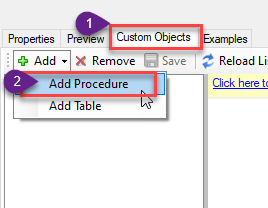
-
Enter the desired Procedure name and click on OK:

-
Select the created Stored Procedure and write the your desired stored procedure and Save it and it will create the custom stored procedure in the ZappySys Driver:
Here is an example stored procedure for ZappySys Driver. You can insert Placeholders anywhere inside Procedure Body. Read more about placeholders here
CREATE PROCEDURE [usp_get_orders] @fromdate = '<<yyyy-MM-dd,FUN_TODAY>>' AS SELECT * FROM Orders where OrderDate >= '<@fromdate>';
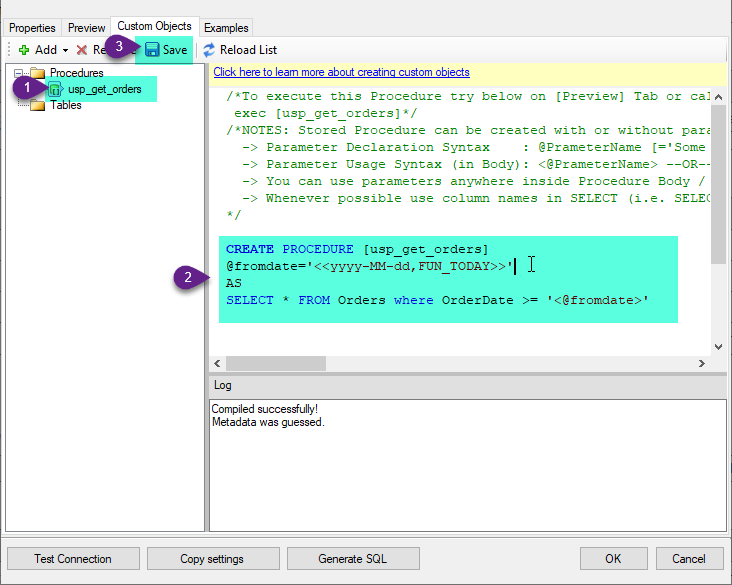
-
That's it now go to Preview Tab and Execute your Stored Procedure using Exec Command. In this example it will extract the orders from the date 1996-01-01:
Exec usp_get_orders '1996-01-01';
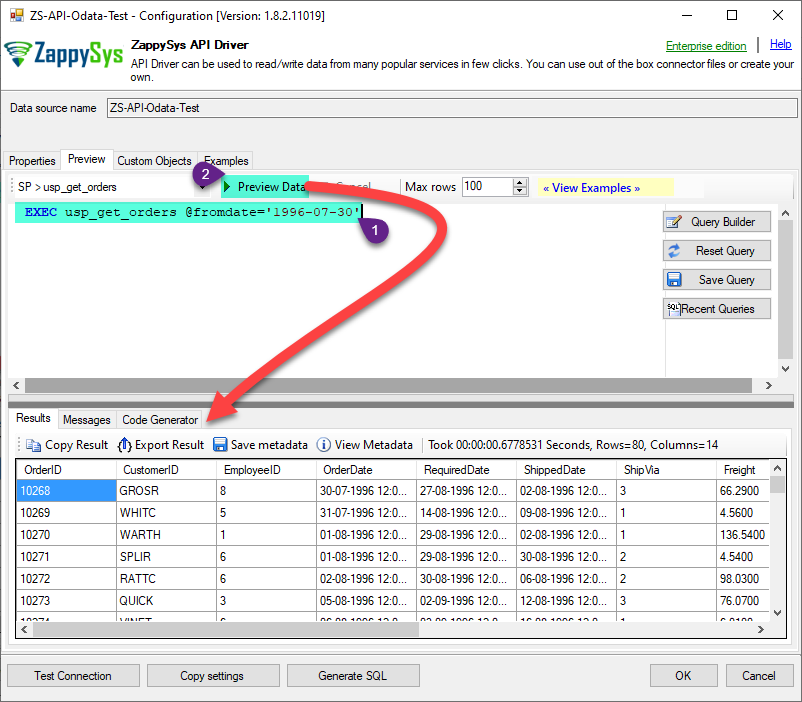
Create Custom Virtual Table
ZappySys API Drivers support flexible Query language so you can override Default Properties you configured on Data Source such as URL, Body. This way you don't have to create multiple Data Sources if you like to read data from multiple EndPoints. However not every application support supplying custom SQL to driver so you can only select Table from list returned from driver.
If you're dealing with Microsoft Access and need to import data from an SQL query, it's important to note that Access doesn't allow direct import of SQL queries. Instead, you can create custom objects (Virtual Tables) to handle the import process.
Many applications like MS Access, Informatica Designer wont give you option to specify custom SQL when you import Objects. In such case Virtual Table is very useful. You can create many Virtual Tables on the same Data Source (e.g. If you have 50 URLs with slight variations you can create virtual tables with just URL as Parameter setting.
-
Go to Custom Objects Tab and Click on Add button and Select Add Table:
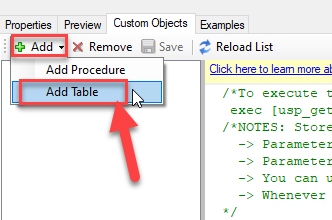
-
Enter the desired Table name and click on OK:
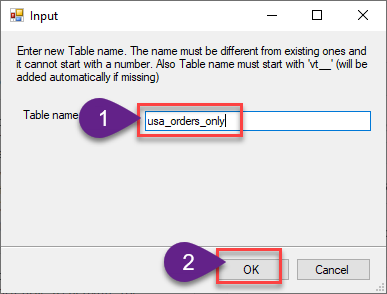
-
And it will open the New Query Window Click on Cancel to close that window and go to Custom Objects Tab.
-
Select the created table, Select Text Type AS SQL and write the your desired SQL Query and Save it and it will create the custom table in the ZappySys Driver:
Here is an example SQL query for ZappySys Driver. You can insert Placeholders also. Read more about placeholders here
SELECT "ShipCountry", "OrderID", "CustomerID", "EmployeeID", "OrderDate", "RequiredDate", "ShippedDate", "ShipVia", "Freight", "ShipName", "ShipAddress", "ShipCity", "ShipRegion", "ShipPostalCode" FROM "Orders" Where "ShipCountry"='USA'
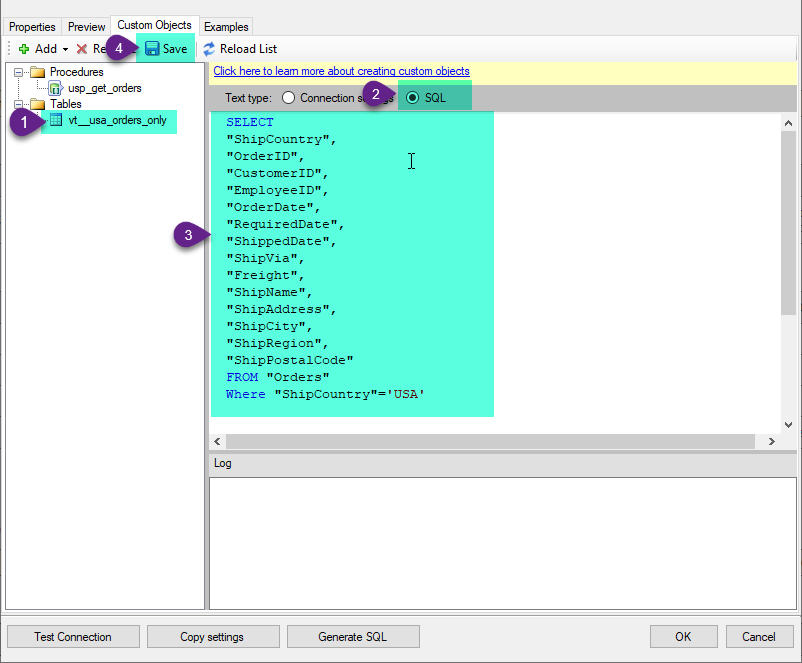
-
That's it now go to Preview Tab and Execute your custom virtual table query. In this example it will extract the orders for the USA Shipping Country only:
SELECT * FROM "vt__usa_orders_only"
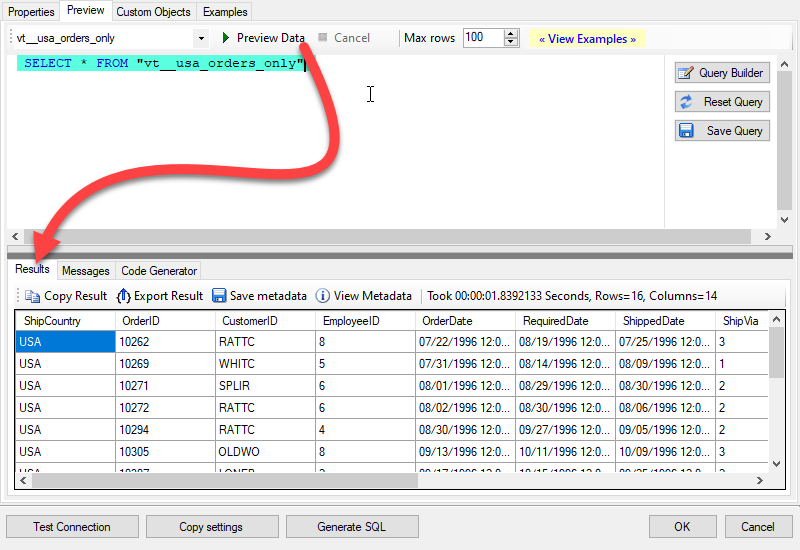
Query Work Items in SSAS
-
Start by right-clicking on Data Source Views and then choosing New Data Source View...:
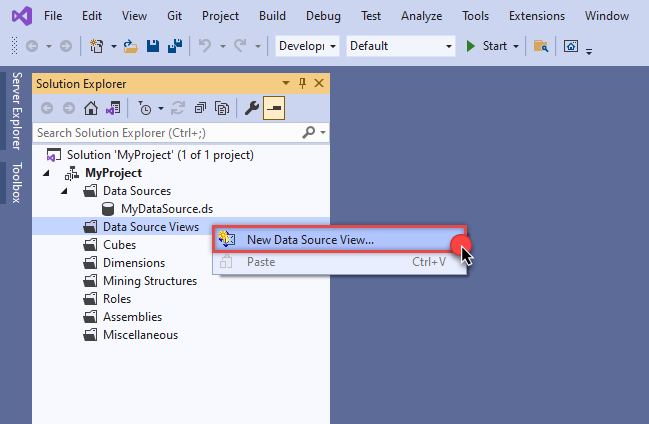
-
Select the previously created data source and click Next:

-
Ignore the Name Matching window and click Next.
-
Add the tables you will use in your SSAS cube:
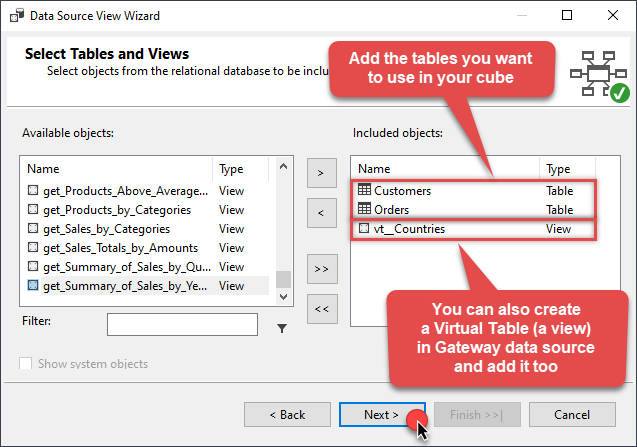 For cube dimensions, consider creating a Virtual Table in the Data Gateway's data source. Use the
For cube dimensions, consider creating a Virtual Table in the Data Gateway's data source. Use theDISTINCTkeyword in theSELECTstatement to get unique values from the facts table, like this:SELECT DISTINCT Country FROM CustomersFor demonstration purposes we are using sample tables which may not be available in Azure DevOps. -
Review your data source view and click Finish:

-
Add the missing table relationships and you're done!
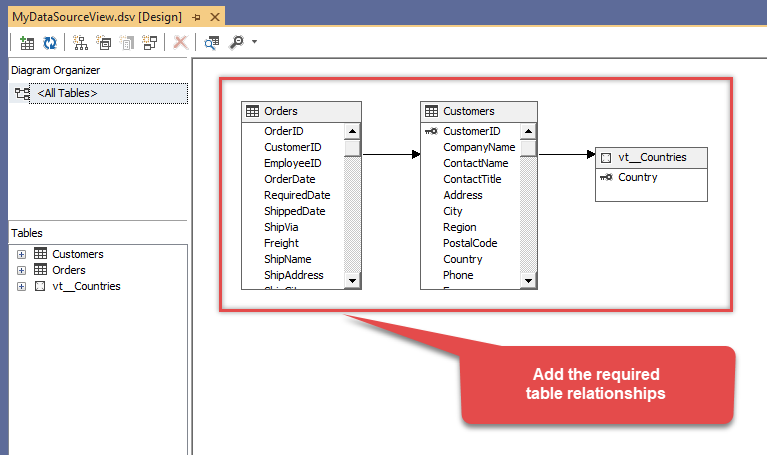
More actions supported by Azure DevOps Connector
Learn how to perform other actions directly in SSAS with these how-to guides:
- Create Project
- Create Team
- Create Work Item
- Create Work Item Comment
- Delete Project
- Delete Team
- Delete Work Item
- Delete Work Item Comment
- Get List of Projects
- Get List of Queries
- Get List of Teams
- Get Project Details
- Get Query Fileds
- Get Team Details
- Get Team Iteration Capacities
- Get Team Iterations
- Get Team Members
- Get Work Item Column Fields
- Get Work Item Comment by Comment Id and Work Item Id
- Get Work Item Comments (by WorkItem Id)
- Get Work Item Types
- Get Work Items by Ids
- Get Work Items for Specified Query Id
- Query Work Item Comments
- Search for Work Items by Text
- Update Project
- Update Team
- Update Work Item
- Update Work Item Comment
- Make Generic API Request
- Make Generic API Request (Bulk Write)

